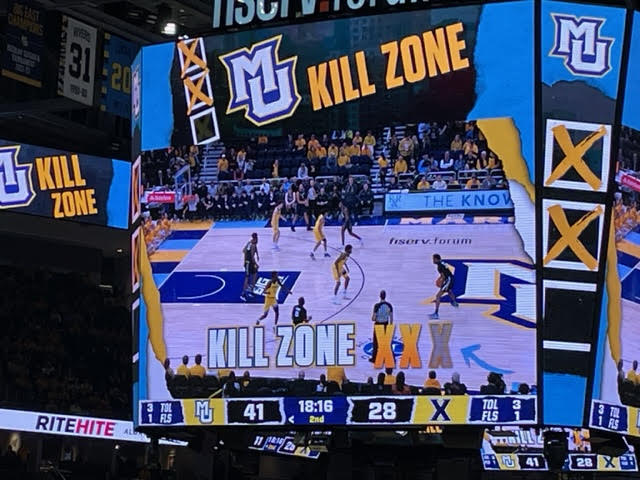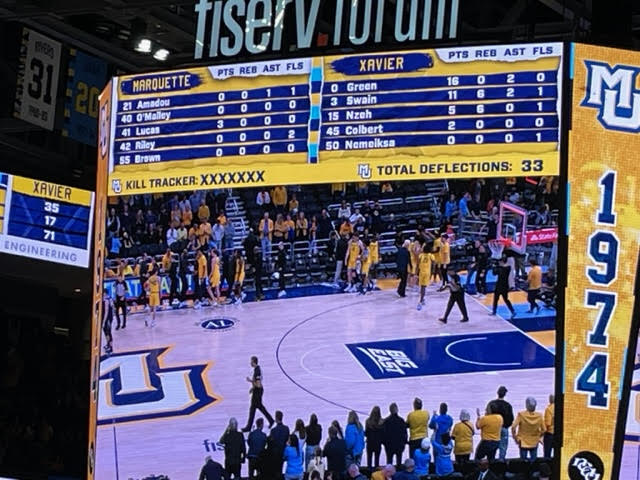My uncle, John Fuzak, was in town recently as the NCAA Basketball Tourney tipped off. Uncle Johnny was a heck of a student-athlete, who ignored big-school scholarship offers to attend central Michigan’s tiny Alma College, where he was assured he’d get the chance to pursue all 3 of his sports – football, basketball and baseball.
He was a 12-time letterwinner with multiple honors and was inducted into Alma College’s Hall of Fame. Despite playing for a small school in a small market, he was drafted by the San Francisco Giants in 1970, though he spurned their offer to enter law school at Indiana University.
During, at and after my mom’s recent funeral, basketball consumed a lot of conversation. Eventually, we got to talking about the famed 1954 Milan (Indiana) High School team that inspired one of our favorite all-time films, Hoosiers. With a total enrollment of 161, tiny Milan High beat Muncie Central (a school with a 10-times higher student body to draw from) in the 1954 Indiana High School Boys Basketball Tournament held at the Butler Fieldhouse.
In those days, there was only one state champion (unlike multiple enrollment-based divisions today), and all the small farm-community schools had to square up against all the big boys from the big cities.
My son, Drew, joined in on the discussion stating Milan’s starting center, Gene White (whose dad owned a local feed store -- another piece of trivia), was just 5-11, which adds to the “David vs. Goliath” magnitude of that victory.
Uncle Johnny Explains …
“I was all of just 6-1, but I had that big ‘Fuzak’ butt and boxed out like a son of a gun,” recalls my uncle when asked about his college playing days. “I may not have gotten the rebound, but in most cases, my opponent wouldn’t either.”

Undersized at 6-1, John Fuzak had a remarkable Hall of Fame career at Michigan’s Alma College. A rare 3-sport athlete, the Alma HOF notes that “few athletes have a more impressive record on and off the playing fields than John Fuzak.”
I was too young to get to see Uncle Johnny play for the Scots, but have no doubt he was a banging, “give 100% til the whistle blows” type post player who’d also irritate the living #$@&!% out of his opponents. And guessing he'd make a taller-yet-softer player think twice about entering the paint.
Uncle Johnny’s answer about giving up the individual rebound to instead cancel out his opponent’s stat line was still percolating as I watched the NCAA first round from the stands in Milwaukee and every game since.
As a bit of stat-geek in sports and business, it occurred that we’re making too much of the individual rebound stat. Yes, it’s vitally important and a key to victory, but the hardest work is not in securing the ball. It’s what happens on the floor before the ball touches iron.
What’s Really Job 1?
“Job 1” should not be about padding one’s individual rebound stats. Instead, like my uncle, one’s mission should be to keep your opponent from getting near the ball. Thus, “Rebounds Recorded by Guarded Opponent” or some variation of those words should be the stat that is most measured – and dictates who deserves to be on the floor.
I learned yesterday that the NBA teams track an array of box-out stats. But if box-out stats are tracked at the collegiate level, we don't hear about it from the sports media, analysts nor coaches -- not even from my main “metric-man” Shaka Smart of Marquette University (scroll below to view earlier columns on his approach to metrics).
Truly successful teams – regardless of whether sports, business or anything else – well know that their “W” is hardly an individual effort. Yes, the salesman or exec may get the accolades, but none of those sales or other achievements – at least not the repeat sale – is possible without myriad individuals sacrificing and backing them up.
The big wins come from a series of little victories stacked up by those committed to “doing the mundane with great enthusiasm.”
A lot of things must go right – and through sheer effort, care and one’s “motor” – to allow your colleague to go up and collect the ball. The big “wins” come from a series of little victories stacked up by those committed to “doing the mundane with great enthusiasm.”
As you take in this week’s Final Four games, watch the players doing the real toiling in the paint and perimeter so their teammates can secure the rebound. You’ll see who tirelessly boxes out – but whose efforts will never be reflected in the box score. And I’m willing to bet that the team who is victorious next Monday night will have several who fit that bill.
P.S. After Monday’s championship game, I intend to scrub the box-out stats to help identify a pattern for my 2026 bracket …
Related Content: Farm Equipment Lessons from the ‘Glory Days’
Original Post: February 26, 2024
Smart’ Lessons for Metrics that Move You to Win
Gamifying what counts & rallying your team around it leads to successful results.
Those of you who know me, or know America’s Dairyland, will understand that a true University of Wisconsin fan cannot also be a Marquette University fan. Just as families have been torn apart by their allegiances to the Cardinal and White or if they’re unfortunate, the Blue & Gold, so it exists in the Lessiter Media offices. It’s an uncomfortably tight race in our offices, due to younger folk like Kim Schmidt and Mackane Vogel, both graduates of the MU’s journalism school. On the Badger side, there’s just me, Michael Ellis and Tealin Robinson. (Yes, now that this has been acknowledged, there’ll be a discussion this week with our H.R. director about background checks.)
But I’ll take good business lessons anywhere we can find them, and I was struck by several things during yesterday’s butt-kicking of Xavier, the 5th-ranked Marquette’s most recent opponent. I accompanied my Marquette-fan son, Drew (listen, nobody said he was perfect), to the game at Milwaukee’s Fiserv Forum, which also included a special 50-year reunion of Al McGuire’s 1974 NCAA national runner-up squad.

Drew Lessiter convinced his dad to see how Wisconsin’s other college basketball team gets things done.
As Coach Shaka Smart (a longtime favorite of our company, back to the days when we owned and operated a basketball coaching publication, which Smart was always gracious with his time and materials) and his squad handed Xavier their hat, I was noting the metrics on the giant Fiserv Forum jumbotron. The most notable was the “Kill Tracker” and jumbotron graphics that would alert everyone in the building when the squad was in a “Kill Zone.”

Wisconsin native Shaka Smart is known for a high-energy coaching style that he established at Virginia Commonwealth and Texas and brought to Marquette in 2021.
Since it was my first in-person Marquette game of the season, the tally of Kills and Deflections, and the Kill Zone graphic, were new concepts to me. During a timeout, I found a great article by Kaylynn Wright, assistant sports editor of the Marquette Tribune, the same newspaper that Kim Schmidt edited in her day.
What was going on was Smart’s gamification of the metrics core to the success of his team.
Wright’s late-December article, summarized here, quickly defined the terms. And as you get ready to complete your NCAA March Madness brackets next month, you might want to pay attention to metrics on which you can measure your own best picks. Here’s the full article.
The kill is defined as 3 consecutive defensive stops. Smart wants his team notching a total of 8 kills per game, which means a series of 24 defensive stops. As Wright notes, the words “kill zone” flash on the jumbotron when Marquette is one stop away from getting another kill, which in turn stirs up the crowd.
Additionally, there’s the “Skunk” and the “Dead Skunk. A “skunk” is 6 defensive stops or 2 kills in a row. A “dead skunk” is 9 defensive stops or 3 consecutive kills.

Kill Zone

Skunk Zone
The other metric tracked on the jumbotron all game long was “deflections.” A deflection is anytime a defensive player gets a hand on the ball. The goal is 32 deflections per game, and during each huddle, the team manager holds up a whiteboard with the accumulated total.
Smart is an outstanding motivator and has been since our first interaction with him when he was a player. And I’ll say most of his metrics could be applied well beyond the 94 feet of the basketball court, including your, and my, businesses. Here’s just a few for you to envision in your company:
Domino – The domino effect summarizes the individual whose actions build up teammates and positively impact everyone on the team. “The domino is ‘How do I make the guys around me better?” says Smart. “The reality is we want to be a team who’s whole is greater than the sum of our parts.”
EGB – It stands for “energy-generating behavior” that boosts the entire team. EGBs can come from anywhere: players, coaches and even fans. While chest bumps might be a little “much” inside your agribusiness, high-5’s and fist-bumps could be measured, just as Smart has tracked them from the first day of practice.
Lost In the Fight –This is the unconscious effort of everything you can to achieve the goal while blocking out all else. “When we get lost in a fight, what I mean by that is we let go of all the other stuff that can creep into the mind, the doubts, anxieties, worries, all the stuff on social media,” Smart says.
Multiple Efforts – Here, Smart means perseverance and giving your all in everything you do; it’s an important requirement of a demanding culture of execution and excellence.
With each of these there’s also recognition for those that “champion” what he wants everyone working toward.

At the game’s end in its victory over Xavier, Marquette had 7 kills (one short of goal) and 33 deflections (ahead of goal).
And finally, there’s “Relationships, Growth, Victory.” This phrase is Smart’s 3 core values installed for the program since his arrival in 2021. A 26-page culture document outlined his beliefs in detail, and he shares it with players, staff and recruits. As Smart says, it lays out “who we want to be, who we strive every day to become and knowing that we’re never going to be perfect. Our culture doc includes our mission to create and sustain championship-level success, and that’s not just on the court in games, that’s in everything we do.”
Have you thought about gamifying what matters most to your results? Let us know how you do it.






